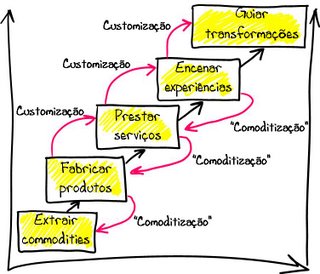Empresas grandes e muito grandes.
Assim, é natural que as consultoras grandes dourem a pílula para os seus clientes no que diz respeito a Mongo.
Por mim, não creio que isto que se segue seja generalizável:
"Scale and customer intimacy.Continuo a crer que os trade-off existirão e cada vez com mais força. Recordar "Tu não és meu irmão de sangue"
Some companies become synonymous with an era and help to define its characteristics. General Motors—the first company to create a multidivisional structure—exemplified the “professional management” era. GE, with its stock price rising nearly fortyfold under Jack Welch, typified the shareholder primacy era. Today, it is tech-based disrupters such as Google, Facebook, Tencent, Tesla, Alibaba and Amazon—as well more established companies like Vanguard, Starbucks, Haier and LEGO—that symbolize the emerging era. In their own ways, they each exemplify a new firm objective: to compete using the benefits of scale and the benefits of customer intimacy.
.
This is a change from the past. A long-held central belief of strategy has been that you can be big and low cost, or you can be focused and differentiated—but not both. We have studied dozens of industries and found practically no correlation between scale leadership and leadership in customer advocacy. In fact, sometimes it’s an inverse relationship—that is, the bigger the firm is in its industry, the less likely it is to be the customer advocacy leader. But what if you could drive scale and experience and, at the same time, learn quickly what customers want and react to their changing preferences? Today, new technologies and analytic techniques are making it possible to minimize or eliminate the traditional trade-off.
...
Underlying the historic trade-off between scale and intimacy is another very real tension—this one between size and speed. A constant throughout all eras, especially the professional management and shareholder primacy eras, was that scale matters—particularly scale relative to your competition. Relative market share, properly defined, was highly correlated with profitability and return on capital in most industries.
.
For firms of the future, scale will still offer potential benefits. But the dynamics of scale are changing. First, it is now possible even for small firms to access the benefits of scale without owning assets or capabilities themselves. Amazon Web Services, Salesforce, Workday and ServiceNow are at the forefront of a new wave of cloud-based capabilities that others can rent for a price. Second, the importance of speed relative to scale has increased across multiple fronts: time to market, time to gather and learn from feedback, time to make and execute decisions. Speed is now essential to customer intimacy. If people in customer-facing roles can make quick decisions and continuously improve their products and services, they will outstrip competitors. Third, just as digital technology and changing consumer expectations are pushing organizations to raise their metabolic rate, size often gets in the way. Bain studies of organizational fitness reveal that companies with more than $25 billion in sales are more likely to be slower at decision making than their smaller competitors.
.
The experience curve was an essential tool for realizing the benefits of size: With more scale and experience comes the opportunity to decrease your costs. But firms of the future will have to develop a new kind of experience curve, one that takes speed as well as scale into account. They will need metrics that track their metabolic rate. They will need systems of operation that allow teams to work quickly on a specific problem, solve it and move on, rather than staying trapped inside annual planning and activity cycles."

























